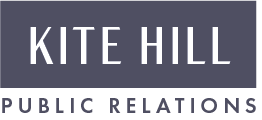Let me be a broken record for a moment and re-remind you that the last six months have brought more disruption than Google did in the mid-2000s.
Every industry is in perpetual survival mode, and PR is no exception. In mid-March, PR teams were either standing in front of a crisis management firehose, crafting messaging for stakeholders, or steeling for budget cuts and layoffs. Some had to deal with both ends of the spectrum. Confronted with smaller budgets and higher expectations, PR practitioners joined the country in adapting to work in near isolation.
Our team at Kite Hill PR has always been agile, dynamic and tight-knit (quite literally, we pioneered an agile approach to PR with the PR Sprint™ Workflow). Our office is not only the place where we meet with clients and ring the bell when major wins are secured, it’s the place where we motivate and push each other to do our best work. Pre-pandemic there was a sense that the physical office space was what was needed to be a successful team. Now, after working remotely for six months and addressing roadblocks head on, we’ve realized that our team was purpose-built to lead high-performing communications programs for our clients, regardless of where we are.
How do we do it? Below are a few initial tips to ensure your team is motivated, connected, and ultimately driving successful results for clients.
Communicate – Then Communicate Some More
One of the biggest challenges faced when working remotely is miscommunication. Digital communication presents new ways to misinterpret messages – there is very little body language to rely on, few context clues, and nearly zero way to interpret tone of voice. This means teams must initiate communications across multiple platforms. Identify the way clients or teammates prefer to communicate and use that as your primary communication platform. So, pick a communications ‘lane,’ but don’t discard other methods.
Perhaps your client prefers talking on the phone – that’s great! It is easier to be clear about activity and expectations over the phone, but the best next step is to send a follow up message recapping your conversation so everyone is aligned. Another example is that a teammate you manage prefers to get real-time feedback over Slack – this is beneficial because you might be able to better articulate that feedback. The next best steps here are to recap your conversation over email and, in your next 1:1, ask if they have any questions and clearly understand the feedback.
Instill Trust Among Clients and Team Members
During times of uncertainty it’s important to remember that clients and co-workers are humans and that in these situations the initial response is typically to put your guard up and not be as openly trusting. This is when PR agencies and in-house teams can be truly tested and must continually build stronger relationships with clients and the business units they support. In a virtual world not all “typical” communications activity resonates. As the pandemic began, one thing we did at Kite Hill was to immediately shift our way of thinking about PR. We positioned ourselves as trusted advisors to our clients by pivoting our PR programs in three key ways:
Shifting events to virtual formats
Revising thought leadership campaigns
Refining internal and external communications
Not only did this nimble shift in strategy support our clients’ needs, it instilled additional trust. They knew they could count on us to guide them through confusing and delicate situations, while simultaneously continuing to prioritize their high level business objectives. When our clients saw the positive results of adapting to this mindset, we decided to create a playbook about it.
Remain Agile in Your Work
The above example also showcases why agility is a key ingredient to creating a high-performing communications team in a virtual environment. Pre-pandemic, we used our PR Sprint™ Workflow on a regular basis to enlist the entire team’s thinking on challenges in stand-up meetings. During lock-down, we adapted our sprint meetings to virtual ones by using Monday.com, which we’re now using agency-wide for project management as well.
An agile mindset during a crisis allows PR professionals to shine if they are able to quickly pivot and adjust to unknown situations. While we continue to do mid- to long-term planning, we approach every day with the knowledge that anything can happen and air tight strategies might need to shift in a nanosecond. Clients’ work environments and priorities are changing faster than ever before, and will continue to do so over the next year, at least. Teams who have a nimble mindset, who are willing to regularly ask questions and reassess activity as needed, can give clients or the businesses they serve the assurance that their PR programs will continue with strategic, forward-momentum.
Embodying agility in PR leads back to instilling trust and strategic communication. Our team knows that each decision our agency makes is done with the utmost consideration for each team member, and that those decisions are communicated in a timely and transparent manner.
If we’ve learned one thing over the last six months, it’s that regardless of where we’re working, we can always create meaningful partnerships with our clients, remain strategic and thoughtful with our PR programs, and build a stronger sense of camaraderie and trust within our agency.
- Emma Wolfe, Senior Director
